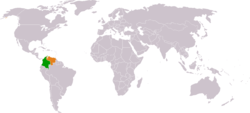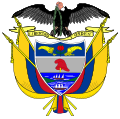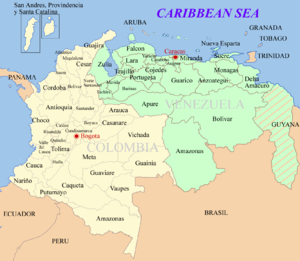- Colombia–Venezuela relations
-
Colombia–Venezuela relations 

Colombia
VenezuelaColombia–Venezuela relations refers to the diplomatic relations between Colombia and Venezuela. The relationship has developed since the early 16th century, when Spanish empire colonizers created the Province of Santa Marta (now Colombia)[1][unreliable source?] and the Province of New Andalucia (now Venezuela).[2] The countries share a history for achieving their independence under Simón Bolívar and becoming one nation—the Gran Colombia—which dissolved in the 19th century.[3] Following then, the overall relationship between the two countries has vacillated between cooperation and bilateral struggle. Diplomatic relations were severed on 22 July 2010 but were re-established on 10 August, following the inauguration of Colombia's new president.
Contents
History
These neighboring countries share a similar history as parts of the Spanish Empire. The border dispute long predates the foundations of the modern nations, and goes back to the difficulties experienced in shaping a boundary between the colonies of Santa Marta (now Santa Marta, Colombia) and New Andalusia (now part of Venezuela). During the colonial era the Guajira Peninsula—then inhabited by the Wayuu indigenous group—resisted the invasion of the Spaniards coming from Santa Marta and New Andalusia, a situation which prevented the colonies from delimiting their territories in the area. The Wayuu tribes were finally subdued by the end of the colonial period with the independence of both colonies in the early 19th century. The new independent territories began formal negotiations to divide the Guajira peninsula in a longitudinal manner. Negotiations failed and the parties asked Spain to intervene. In 1891 the Spanish crown issued a judgment but failed once again to delimit the border because of confusing geographical locations.[4]
Since the 20th century the relationship has evolved with ups and downs mostly regarding the Colombia–Venezuela maritime territory dispute over the Gulf of Venezuela. The lowest point in the relationship occurred on August 19, 1987, after the Colombian corvette Jaime Lusinchi, ordered the Venezuelan Air Force to the area. The standoff was resolved through diplomatic channels but the dispute remained.[5]
One of the main issues has been the large wave of Colombians who migrated to Venezuela in the 1970s and 1980s, working primarily in low-end jobs. Many Colombian immigrants were imprisoned in Venezuela and kept poor, faced discrimination and endured human rights violations.[6] The Colombian armed conflict between the Colombian government and guerrilla groups has also provoked impasses between the two countries. Military illegal incursions by the two countries' military forces into each others' territory have been frequent since the conflict in Colombia escalated in the 1980s, which subsequently triggered forced displacements in Colombia and into Venezuela. Illegally armed groups also trespassed into Venezuela. Contraband flows from one territory to another depending on supply and demand along the shared porous border of 1,375 miles (2,210 km). Illegal products range from gasoline, drugs and weapons to stolen cars. Since 2002, the relationship between Venezuela and Colombia has fluctuated due to ideological differences that separate Presidents Hugo Chávez and Álvaro Uribe, respectively. The relationship between the two countries once again reached a low point in November 2007 after a failed effort to achieve a humanitarian exchange, causing relations to freeze.[7]
1922–1941
- End of land border dispute
Bilateral negotiations continued; in 1922 the Swiss Federal Council was petitioned to give a second opinion, which did not occur. In 1939 the Venezuelan government issued a decree imposing a maritime border line from the village of Castilletes in Guajira Peninsula to Paraguaná Peninsula which result in most of the Gulf belonging to Venezuela. The Colombian government reacted to this in the late 1940s asking the Venezuelan government to rectify and draw a middle line in accordance with the United Nations Convention on the Law of the Sea.
In 1941 once again bilateral negotiations resumed settling the territorial border, but setting a new round of differences regarding the maritime territory.[4]
1941–1987
On April 5, 1941, Colombia and Venezuela created the Tratado de delimitación terrestre y de navegación de ríos comunes (Common rivers navigation and terrestrial delimitation treaty).[8]
Secession of Los Monjes Archipelago
On November 22, 1952, the Colombian government renounced its claims over the Los Monjes Archipelago.[8] The treaty was signed by chancellors Esteban Gil Borges, from Venezuela and Luis López de Mesa, from Colombia, with the presence of the ambassadors Santiago Rodríguez and Alberto Pumarejo in the city of Cúcuta.[9]
1987–1991
The Caldas frigate crisis
 The ARC Caldas (FM-52) is an Almirante Padilla class frigate
The ARC Caldas (FM-52) is an Almirante Padilla class frigate
Tensions escalated on August 11, 1987, as a result of the Caldas frigate incident. The Colombian guided missile frigate Caldas refuse to leave the disputed waters claiming they belonged to Colombia.[8] The Venezuelan government reacted by sending a fleet of F-16 fighter jets and almost engaging in combat.
Once again, on June 20, 1989, Colombia and Venezuela created the Comisión de vecindad Colombo-Venezolana (Colombo-Venezuelan neighborhood Commission).[8] Colombia and Venezuela then signed the Accord of Open Skies on May 18, 1991. Both countries also create the Comisión mixta para el control del tráfico de estupefacientes (Mixed Commission for the Control of Illegal Drugs Traffic).[8]
1994–1998 – Combifron
See also: Ernesto Samper and Rafael CalderaIn 1994 Colombian and Venezuelan government created the Comisión binacional de Fronteras (Combifron) or "Binational Commission of Frontiers" which intended to exchange military intelligence between the two countries.[8]
1995 – ELN incursion in Venezuela
On February 25, 1995, the Colombian guerrilla group National Liberation Army (ELN) attacked a fluvial military post, penetrating on the Venezuelan side and killing 8 Venezuelans and injuring 12 Marines.[8]
1998–2002
On April 30, 1998, The ELN guerrilla assaulted the Colombian border town of Ragonvalia. After the attacks the guerrillas crossed the border into Venezuela. Venezuelan president Rafael Caldera authorized the Colombian Army to enter Venezuela and fight the guerrillas.[8]
2000 – Venezuelan military incursion in Colombia
On March 21, 2000, Four Venezuelan helicopters and two airplanes entered Colombian airspace and bombarded an area in the jungle region of Catatumbo, in the Department of North Santander. On April 23, Colombian and Venezuelan governments signed an accord of understanding the issues of population displacement. This in regards to the Colombian nationals displaced by the conflict and crossing into Venezuela. Between May and June 2000, Venezuelan truckers blocked the border crossing between the two countries protesting the lack of guarantees for their safety in Colombia due to the constant attacks perpetrated by the Colombian guerrillas.[8]
2001 – Ballestas case
In February 2001 the ELN commander José María Ballestas, accused in Colombia of hijacking an Avianca airplane, was captured in Venezuela but later released causing diplomatic tensions between the governments of Hugo Chávez and Andrés Pastrana.[10]
Ballestas was later recaptured by Venezuelan authorities and in December 2001, was extradited from Venezuela to Colombia.[10]
2002 – Coup d'état against Hugo Chávez
After the 2002 Venezuelan coup d'état attempt toppled Chávez for two days, Pedro Carmona fled house arrest and asked for political asylum at the Colombian ambassador's residence in Caracas, which he was later granted. The government of Hugo Chávez criticized the decision but granted Carmona safe passage out of Venezuela.
2002–2008
See also: Álvaro Uribe, Plan Colombia, Rodrigo Granda affair, Humanitarian exchange, and Colombia–United States relationsThe relationship between the Hugo Chávez and Álvaro Uribe administrations has been marked by up and downs.
Rodrigo Granda
In 2004 the relationship became strained again in the Rodrigo Granda affair, with the kidnapping in Caracas of Colombian-Venezuelan naturalized guerrilla member Rodrigo Granda. Granda was transported by his captors to the border city of Cúcuta in Colombia and taken into custody by the Colombian National Police on rebellion charges.
2007 – Post-humanitarian exchange negotiation
In late 2007 Colombian President Álvaro Uribe, through his appointed negotiator Piedad Córdoba, contacted Venezuelan President Hugo Chávez to facilitate the humanitarian exchange negotiations of prisoners for hostages between the government of Colombia and the Revolutionary Armed Forces of Colombia.
During a private meeting at the 2007 Ibero-American Summit, Uribe told Chávez not to contact Colombian military commanders. Two weeks after the summit, Senator Piedad Córdoba got on the phone with the General of the Colombian National Army Mario Montoya Uribe. The issue was reported to Uribe who publicly announced the interruption of Chávez and Córdoba as facilitators.
Operation Emmanuel
Main article: Operation EmmanuelWhile relations between the two governments continued to be strained, on December 27, 2007, Chávez publicly said that he had a plan set up to rescue the three hostages promised to Chávez by the FARC guerrilla in compensation. This was after Colombian president Uribe decided to end the mediation by Chávez and Piedad Córdoba.[11]
Operation Emmanuel used Venezuelan aircraft in coordination with the International Red Cross to fly into Colombia and rescue the hostages from the FARC.
Operation Road to Freedom
In February 2008, the Venezuelan government launched a new operation to liberate four more hostages held by the FARC: Luis Eladio Perez, Orlando Beltran, Gloria Polanco and Jorge Eduardo Géchem all of them former senators kidnapped by the FARC in order to pressure the Colombian government.
2008 Andean diplomatic crisis
Main article: 2008 Andean diplomatic crisisOn March 1, 2008, the Colombian military launched an attack against FARC in the border area between Colombia and Ecuador, which ended with the death of some 19 guerrillas, including the group's second-in-command Raúl Reyes. The attack targeted a guerrilla camp some 1.8 km inside Ecuadorean territory.
Colombian president Álvaro Uribe called Ecuadorean president Rafael Correa, arguing that Colombian forces had crossed the border during combat in pursuit of the guerrillas. Correa said he would investigate the events and later accused the Colombian government of lying, recalling his ambassador in Bogotá. The Colombian government subsequently apologized for its actions.
Reacting to the event, Hugo Chávez stated that if Colombia launched a similar operation within Venezuelan borders he would consider it a casus belli and verbally attacked the Colombian president. Chavez ordered ten national guard battalions to the Colombia–Venezuela border and closed its embassy in Bogotá. Chavez also offered his support to Ecuadorean president Correa. On March 9, 2008, the Venezuelan government announced that it was re-establishing normal diplomatic ties with Colombia.[12]
Chavez asked Latin American nations and the European Union to remove FARC from their lists of terrorist organizations, which they roundly refused to do. FARC was added to the European Union's list in 2002 after the kidnapping of Íngrid Betancourt, one of the 700 hostages held by FARC as of 2008.[13][14] In June 2008 Chávez worked to get FARC rebels in Colombia to release hostages and end their war against the Colombian government. Later, he withdrew his support for FARC.[15]
2009
See also: Los Maniceros massacreIn late July, the Colombian government claimed that AT4 anti-tank rockets manufactured by Saab Bofors Dynamics of Sweden, which were later purchased by Venezuela were being used by the FARC. In response, President Chavez ordered most staff members of the embassy in Colombia to return to Venezuela, including the ambassador. Only the "lowest functionaries" were left to staff the embassy.[16] Venezuela halted imports of Colombian cars and banned a Colombian energy firm from Venezuela's oil-rich Orinoco region.[17] The Venezuelan ambassador was later sent back to Bogotá.
President Chávez stated that the five anti-tank rockets were stolen when the Colombian guerrilla group FARC attacked a military post in 1995 and took the armaments.[18][19] However, Colombian newsweekly Revista Semana reported that the attack on the Venezuelan outpost in 1995 was actually carried out by the National Liberation Army (ELN) instead of FARC and that Chávez could not explain how the weapons would have passed from one guerrilla group to another. In addition, former Venezuelan military personnel denied that the rockets in question were ever present in the outpost.[20]
There has also been diplomatic tension because Venezuela opposes military deals between Colombia and the United States.[21]
On November 20, 2009, elements from the Venezuelan army destroyed two pedestrian bridges on the border above the Táchira River. According to the inhabitants of the town of Ragonvalia in Northern Santander, several Venezuelan soldiers confronted Colombian civilians and then used explosives to destroy the bridges from the Venezuelan side. Venezuelan authorities acknowledged the event and claimed that it was done as a legitimate way to stop smuggling and drug trafficking. Colombian minister of defense replied: "It's a serious situation and an act of aggression against the civilian population." The Colombian government said that such actions would be brought before the Security Council of the United Nations and the Organization of American States.[22][non-primary source needed]
On December 4, 2009, a Colombian soldier was detained by the Venezuelan National Guard after being found on Venezuelan territory, having apparently crossed the border to take a shortcut. The Colombian government demanded that Venezuela unconditionally release the soldier and return him unharmed. Colombian Minister Gabriel Silva called the action "a new act of aggression" and a "violation of the international human right".[23]
2010
Main article: 2010 Colombia-Venezuela diplomatic crisisThe 2010 Colombia-Venezuela diplomatic crisis was a diplomatic stand-off between Colombia and Venezuela over allegations in July 2010 by outgoing President Álvaro Uribe that the Venezuelan government was actively permitting the Colombian FARC and ELN guerillas to seek safe haven in its territory. Uribe presented evidence to the Organization of American States (OAS) allegedly drawn from laptops acquired in Colombia's 2008 raid on a FARC camp in Ecuador, which had sparked the 2008 Andean diplomatic crisis. In response to the allegations Venezuela broke off diplomatic relations, and there was speculation of a possible war. The crisis was resolved after Juan Manuel Santos was inaugurated as the new President of Colombia on 7 August 2010, and the intervention of UNASUR bringing together Santos and Venezuelan President Hugo Chávez. Chávez told the guerillas that there could be no military solution to the conflict, and Santos agreed to turn over the disputed laptops to the Ecuadorean government. Colombia and Venezuela agreed to re-establish diplomatic relations.
See also
References
- ^ (Spanish) Roa, Alberto Saldarriaga. "Fundación de Santa Marta". Colombialink.com. http://www.colombialink.com/01_INDEX/index_historia/02_la_conquista/0010_fundacion_santamarta.html. Retrieved 2007-11-25.
- ^ (Spanish) Ruano, Maru. "Cumaná". Catholic.net. http://es.catholic.net/escritoresactuales/499/1119/articulo.php?id=11565. Retrieved 2007-11-26.
- ^ Mabry, Donald J. "Gran Colombia and the United Provinces of Central America". Historical Text Archive. http://www.historicaltextarchive.com/sections.php?op=viewarticle&artid=354. Retrieved 2007-11-26.
- ^ a b (Spanish) Sandner, Gerhard (4 October 2007). "El conflicto fronterizo en el Golfo de Venezuela". La Biblioteca Luis Ángel Arango del Banco de la República, lablaa.org. http://www.lablaa.org/blaavirtual/geografia/ctemc/ctemc09b.htm. Retrieved 2007-11-27.
- ^ Tessieri, Enrique. "Latin America's unresolved border disputes". Enrique Tessieri. Archived from the original on 2007-10-09. http://web.archive.org/web/20071009153254/http://www.tessieri.net/texts/latam.html. Retrieved 2007-11-26. Published in Power in Latin America (Issue 129/2004)
- ^ (Spanish) Penalosa Pinzon, Arturo. "Santa Ana, infierno de presos en Venezuela". El Tiempo. http://www.eltiempo.com/justicia/2007-12-17/ARTICULO-WEB-NOTA_INTERIOR-3862781.html. Retrieved 2007-12-17.[dead link]
- ^ (Spanish) Ramirez, Socorro (19 December 2000). "Colombia – Venezuela: construir canales de comunicación para prevenir el conflicto". Analitica.com. Archived from the original on 2007-12-15. http://web.archive.org/web/20071215085321/http://www.analitica.com/va/hispanica/colombia_paz/1417173.asp. Retrieved 2007-11-26.
- ^ a b c d e f g h i El Tiempo (August 10, 2003). "Venezuela Especial: En los confines de Colombia" (in Spanish) (PDF). El Tiempo. http://www.urosario.edu.co/fase1/economia/CEODD/docs/mapa_conflictos_fronterizos.pdf. Retrieved 2008-03-26.[dead link]
- ^ Enrique Gaviria Liévano. (April 2000). "El archipiélago de Los Monjes y las relaciones diplomáticas con Venezuela. Historia de una "cesión" territorial cuyas consecuencias siguen vigentes." (in Spanish). Revista Credencial Historia. http://www.banrep.gov.co/blaavirtual/revistas/credencial/abril2000/124archipielago.htm. Retrieved 2008-03-26.
- ^ a b EFE (August 29, 2006). "Condenan a rebelde ELN detenido en Venezuela por secuestro avión" (in Spanish). Terra.com. http://www.terra.com/noticias/articulo/html/act476401.htm. Retrieved 2008-04-01.
- ^ (Spanish) Vieira, Constanza. "Exitosa misión en busca de Clara y Consuelo". Inter Press Service. http://ipsnoticias.net/nota.asp?idnews=87131. Retrieved 20 February 2011.
- ^ Venezuela resetting diplomatic ties with Colombia
- ^ "EU to keep Farc on 'terror list': The European Union has insisted it will not remove Colombia's Farc rebels from its "terror list", despite recent calls by Venezuelan President Hugo Chávez"
- ^ "FARC are not terrorists: Venezuela's Chavez"
- ^ "Chavez ends support of Farc rebels: Hugo Chávez said he was ending his support for Colombia's Marxist guerillas, robbing them of their most public and powerful ally." article by Jeremy McDermott in Medellín published: 10:23 pm BST 9 June 2008 in Telegraph.co.uk
- ^ Brice, Authur (July 29, 2009). "Venezuela freezes relations with Colombia". CNN. http://www.cnn.com/2009/WORLD/americas/07/28/venezuela.colombia/index.html. Retrieved 2009-07-29.
- ^ "Chavez turns up heat on Colombia". BBC News. August 6, 2009. http://news.bbc.co.uk/2/hi/americas/8186767.stm. Retrieved April 30, 2010.
- ^ "Venezuela & Increased Colombian Militarization". http://www.rethinkvenezuela.com/downloads/Ven-Colombia%20stance.pdf.
- ^ "Chavez fumes at neighbour Colombia". BBC News. August 6, 2009. http://news.bbc.co.uk/1/hi/8188243.stm. Retrieved April 30, 2010.
- ^ "Las mentiras de Chávez". Revista Semana. August 15, 2009. http://www.semana.com/noticias-nacion/mentiras-chavez/127454.aspx. Retrieved May 24, 2010.
- ^ "S. America meeting ends amid deadlock". AFP. 16 September 2009. http://www.google.com/hostednews/afp/article/ALeqM5gwsSSw36T9xUFPHvr0SiCRGz0YJg. Retrieved 2009-09-20.
- ^ "Dos puentes fueron volados en frontera con Venezuela por la Guardia Nacional - Noticias de Justicia en Colombia". Eltiempo.Com. http://www.eltiempo.com/colombia/justicia/venezuela-admite-que-volo-puentes-pero-porque-eran-ilegales-y-estaban-de-su-lado-de-la-frontera_6626647-1. Retrieved 2010-08-12.
- ^ Colombia exigió a Venezuela devolver a soldado capturado por la Guardia Nacional de ese país
External links
- (Spanish) Colombian Ministry of Foreign Affairs
- (Spanish) Venezuelan Ministry of Popular Power for Foreign Affairs
 Foreign relations of Colombia
Foreign relations of ColombiaAsia India · Indonesia · Israel · Japan
Europe Austria · Czech Republic · France · Ireland · Italy · RussiaNorth America Canada · Costa Rica · Cuba · Dominican Republic · El Salvador · Guatemala · Honduras · Jamaica · Mexico · Nicaragua · Panama · United StatesSouth America Multilateral European Union (EU) · United Nations (UN) · Organization of American States (OAS) Foreign relations of Venezuela
Foreign relations of VenezuelaBilateral relations 
Diplomatic initiatives Categories:- Colombia–Venezuela relations
- Bilateral relations of Colombia
- Bilateral relations of Venezuela
Wikimedia Foundation. 2010.


